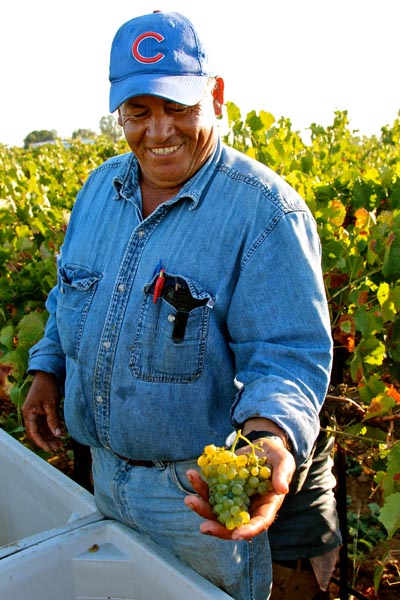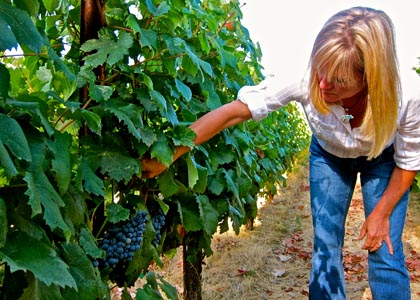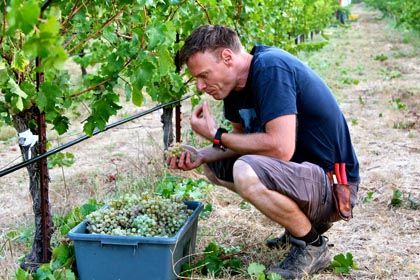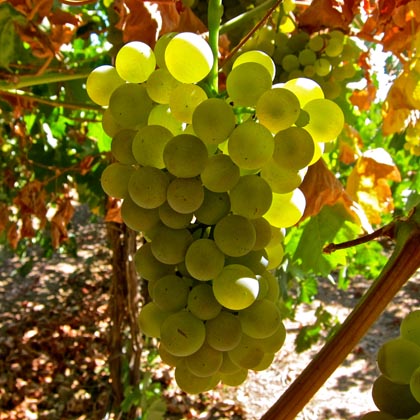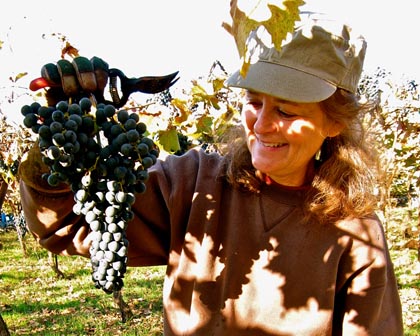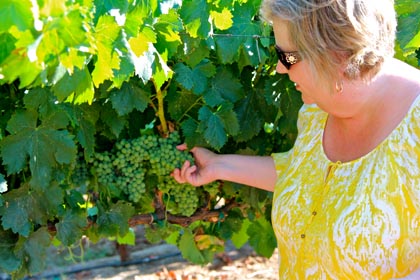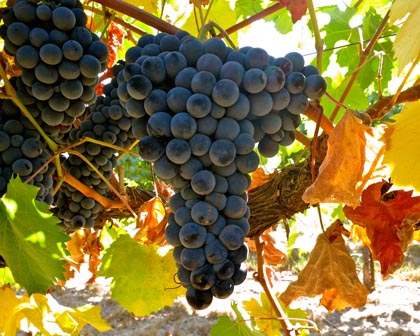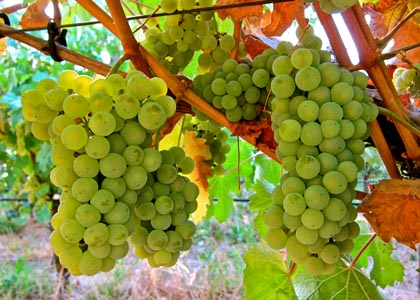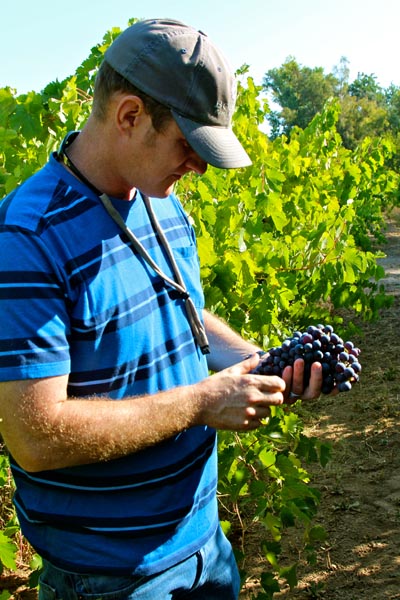Letters from Lodi
An insightful and objective look at viticulture and winemaking from the Lodi
Appellation and the growers and vintners behind these crafts. Told from the
perspective of multi-award winning wine journalist, Randy Caparoso.
Lodi’s thirty-six % solution: delicious wines from less familiar grapes
2013 Verdelho harvest in Lodi’s Silvaspoons Vineyards
One of the more interesting things to come along over the past year have been the "Seven % Solution" tastings popping up here and there. Originally conceived by a Healdsburg wine retailer, the 7% is in reference to the idea that 93% of the wine grape acreage in California's North Coast consists of just eight grapes, going into most of the popular varietal wines sold today: Cabernet Sauvignon, Merlot, Pinot Noir, Syrah, Zinfandel, Petite Sirah, Chardonnay, and Sauvignon Blanc.
However, the Lodi AVA – California's largest single winegrowing region – skews the 7% formulation somewhat. Lodi is steady in multiple ways. First, because of the Delta's farming heritage, the City of Lodi and San Joaquin County's zoning restrictions still make land usage favorable to agriculture (knock on wood).
Second, there is Lodi's location at the mouth of the Sacramento-San Joaquin River Delta; the coastal air funneled through this gap of islands, waterways and levees furnishing a moderate Mediterranean climate comparable to the middle regions of the North Coast, and Paso Robles and Santa Barbara further south.
Liz Bokisch with Graciano in Bokisch Ranches’ Las Cerezas Vineyard
In the heart of the AVA, the historic Mokelumne River's uniquely deep, rich yet superbly well drained Tokay sandy loam – built up from millions of years of finely crushed granite deposited by waters flowing down from the Sierra Nevadas – adds to the favorability. On the hillier western edges of the AVA, diverse sites – from gravelly clays to river rock soils – offer more classic winegrowing terroirs, where much of the broader AVA's growth has occurred over the past 20 years.
Add that all up, and you get a natural confluence of factors very much conducive to balanced ripening of a great variation of Vitis vinifera – from Aglianico to Zweigelt, and as much (actually, mostly more) Cabernet Sauvignon, Merlot, Chardonnay, Pinot Noir, Sauvignon Blanc, et al. as anywhere else on the West Coast.
Even German white wine grapes, such as Riesling and all the variants of Riesling/Sylvaner crossings, have been producing delicious wines in Lodi. You may not have heard about this yet – preconceptions, especially among the press and trade (people who you would think have done their homework, but more often than not haven't), are always hard to overcome – but the fact remains: it's easy as pie to grow virtually any wine grape in a intrinsically moderate region like Lodi.
Borra’s Markus Niggli samples 2013 Kerner in Mokelumne Glen estate
Consequently, Lodi grows more variety of wine grapes than any other region in the state (in the world, for that matter). And contrary to common misperception, Lodi does not grow table grapes or raisin crops (the heyday of the seeded Flame Tokay – a Vitis vinifera once packed for table consumption – came to past in the 1980s). The estimated 308,000 acres of California's grapes grown for fresh eating or raisins come from well south of San Joaquin Valley's District 11. Today, in Lodi, it's all about wine.
If you take the eight varieties cited by the Seven % Solution crowd and apply it to Lodi and the rest of the state, it's really a "Thirty-Six % Solution," since these grapes add up to slightly less than 64% of the wine grapes grown in California (570,000 total acres, as of 2013). The breakdown, according to the USDA's latest California Grape Acreage Report:
Vermentino in Kevin Delu’s Bella Vigna Vineyard
Chardonnay – 97,970 acres
Cabernet Sauvignon – 86,258 acres
Zinfandel – 48,638 acres
Merlot – 45,296 acres
Pinot Noir – 41,301 acres
Syrah – 19,019 acres
Sauvignon Blanc – 15,444 acres
Petite Sirah – 9,576 acres
(total of these eight varieties – 363,502 acres)
Richard "Rip" Ripken of Ripken Vineyards & Winery is one example of a Lodi grower. As one of the region's larger wine grape suppliers, he cultivates some 50 different varieties, selling over 99% of what he grows to commercial wineries, small to big. He often describes his viticultural endeavors as taking a "road less travelled"; although some might see his labors – particularly rows and rows of somewhat obscure (to today's average consumer) grapes such as Carmine, Counoise, Grignolino, Refosco, and Sainte-Macaire – as more like jousting at windmills.
And no, Mr. Ripken's own Ripken brand of Pinot Noir will never be confused with Chambertin, or even Williams Selyem; but it's a sleek, gentle yet snappy, fruit focused, mildly loamy scented red – nothing oppressive or overweening, and not atypical of what's been coming out of Lodi in recent years.
On the other hand, the Ripken label Tinta de Toro (a clonal variant of Tempranillo), Graciano, Tannat, and Port (fashioned from Souzão and Touriga Nacional) all have their own je nais se quoi: even if more like naïve domestic burgundies amusing in their presumption, just the thing for the growing number of wine lovers who, like the Seven % Solutionistas, long for something beyond Cabernet Sauvignon, Zinfandel, or even Pinot Noir.
Are you one of those actively searching out new vinous territories? Then you should consider wines carrying the Lodi appellation on the label.
Barbara Hucksteadt’s rare Marzemino grape, producing Hux “Dave’s Aria”
There is, after all, a growing number of artisanal style producers of good repute or notoriety working outside of Lodi, sourcing from the region precisely because of the numerous grapes at their disposal. To name just a few of these winemakers producing wines right up Seven % consumers' alley: Uvaggio's Jim Moore, Morgan Winery's Dan Lee (under his Lee Family Farm label), Santa Cruz Mountain's Jeff Emery (Quinta Cruz Wines), Thomas Fogarty's Nathan Kandler (Precedent), Onesta's Jillian Johnson, The Scholium Project's Abe Schoener, Forlorn Hope's Matthew Rorick, Odisea/Cochon's Adam Webb, the Replogle family at Fenestra, Jeff Runquist in Amador County, and Greg Stokes and Deborah Elissagaray of Ursa Vineyards in El Dorado.
Within Lodi itself, we are seeing more and more vignerons seriously exploring the uncommon varieties, carving out their own commercial niche in the process. Our recommended wines by some of Lodi's more adventurous producers, actively engaged in the exploration of those 36% "other" grapes cultivated in California:
Acquiesce Winery – A beautifully light, pure, palate stinging Picpoul Blanc, a spring-fresh and fluid Grenache Blanc, and an exquisitely balanced "Belle Blanc" (blend of Grenache Blanc, Roussanne and Viognier).
Acquiesce’s Sue Tipton with her estate grown Picpoul Blanc
Akin Estates – Unrepentantly thick, trenchermanly Tannat.
Bokisch Vineyards – Among the whites, a pretty Garnacha Blanca, citrus skin refreshing Verdejo, a richly textured lemon/lime driven Verdelho, and perhaps the finest Albariño west of Rías Baixas. No-less-interesting reds include a meaty textured Graciano, a finesseful Tempranillo, and a Garnacha suggesting fields of sweet pepper spiced strawberries.
Borra Vineyards – A light, lovely Artist Series White (blend of Kerner, Riesling and Bacchus), and a lithe, zesty, bone dry "nuvola" (Gewürztraminer); not to mention an all-time Lodi classic, Borra's "Field Blend Red" (ancient vine Barbera co-fermented with Carignan, Petite Sirah and Zinfandel).
Egan Cellars – By Bokisch winemaker Elyse Egan Perry; lightly tart, contemporary style Albariño, and a deep, svelte, meaty Tempranillo.
Estate Crush – From among the dozens of wines produced at Lodi's urban custom crush facility and tasting room, look for a fresh, lively Sangiovese and a pure, fragrant Albariño bottled under the house (Estate Crush) label.
Peltier Station’s Mokelumne Rim Vineyard Teroldego
Fields Family Wines – A taut, sturdy yet fleshy rendition of Tempranillo.
Harmony Wynelands – A rare, blustery, exotically scented Alicante Bouschet from ancient vines (planted in 1921) that have recently been pulled out, and an equally fascinating, award winning "GMA" (Grenache/Mourvèdre/Alicante Bouschet blend).
Harney Lane Winery – A delicately flowery, minerally textured Albariño, and a plush, juicy Primitivo (Harney Lane's Lodi Zinfandel is also made from at least 50% Primitivo).
Heritage Oak Winery – A classically tactile, deep, tart edged Charbono (a.k.a. Douce Noir).
Mokelumne Glen Riesling (Neudstadt/clone 90)
Hux Vineyards – A curiously rich, pungent, jaw dropping "Dave's Aria" (from the unheard-of Marzemino grape), and a golden rich, viscous Roussanne.
Jessie's Grove Winery – Deep, rich Carignan made from phenomenal 126-year old vines.
Kidder Family Winery – Look for the Kidders' bright, sinewy, deftly balanced "Duet" (Graciano/Tempranillo blend).
Klinker Brick Winery – A Dolcetto expressing the essence of blackberry, packed into a densely phenolic yet only moderately weighted body.
Macchia Wines – Modernistic interpretation of the classic, zesty Barbera grape, and an ebulliently fruited Primitivo.
Mettler Family Vineyards – Now cultivating a wonderfully rich, broad, satisfyingly fruit focused Pinotage.
McCay Cellars – A bright, scrubby, almost Provençal-like Carignan from 108-year old vines, and a Grenache redolent of red berries and cherries.
Michael David Winery – A gentle, sumptuous, strawberry/rhubarb-ish Cinsault from the historic 128-year old Bechthold Vineyard; and under the Inkblot label, three different, compellingly deep, aromatic, teeth rattling varietal bottlings made from Tannat, Petit Verdot and Cabernet Franc.
Pantheon Cellars – A humongously rich, brooding, muscular proprietary red called Panthos (blend of Petite Sirah, Syrah and Mourvèdre).
Pasos Vineyards – A stout, saturated, thick yet zesty edged Reserve Charbono that will probably live forever.
Peltier Station – A Teroldego that is blood red and damned near as thick, chewy and raw meaty.
Ripken Vineyards & Winery – Definitely look into their richly textured Tinta de Toro (Tempranillo).
Riaza Wines – An earth toned, curvaceously crafted Graciano, sourced from Bokisch Ranches' Terra Alta Vineyard.
Sorelle Winery – A pinpoint, bright and buoyant Barbera, and a cherry, tea, dried leaf nuanced Sangiovese; both as fine as any produced in the U.S.
St. Jorge Winery – A big, hunky Touriga, a full scaled "Vinho Tinto Belo" (blend of Souzão, Tempranillo and Touriga), and a lusciously sweet "Sobremesa" (late picked Torrontés).
Watts Winery & Vineyards – A finely balanced, pungently spiced Montepulciano (a varietal not to be confused with Sangiovese).
De Loach vineyard manager Eric Pooler with historic Mission grapes (first Vitis vinifera planted in California), which go into Buena Vista’s sweet Angelica solera
